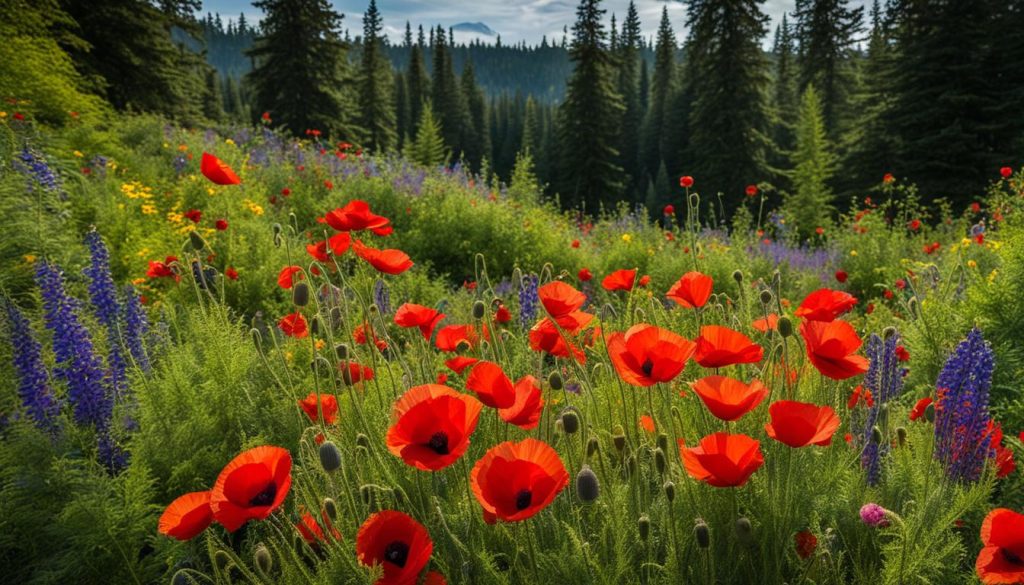If you’re looking to transform your backyard into a stunning oasis that immerses you in the wonders of Canadian nature, you’re in the right place. Our guide covers everything from selecting the perfect blooms to designing eye-catching flower beds and maintaining your garden through the seasons.
At the heart of flower landscaping are the vibrant blooms that bring life and color to your outdoor space. With a carefully chosen selection of flowers, you can create a stunning and unique landscape that reflects your personality and taste.
But flower landscaping isn’t just about aesthetics – there are numerous benefits to incorporating flowers into your outdoor design. Flower landscaping can enhance your home’s curb appeal, attract beneficial insects, and even improve the air quality around your property.
So whether you’re a seasoned gardener or just starting out, we invite you to explore the art of flower landscaping and discover the endless possibilities that await. Let’s get started!
The Benefits of Flower Landscaping
At Landscaping Vaughan, we truly believe that flower landscaping is one of the best investments you can make for your home. Not only does it enhance the curb appeal of your property, but it also offers a plethora of other benefits that you may not have considered before. Here are just a few:
| Benefit | Description |
|---|---|
| Enhanced Curb Appeal | The addition of colorful blooms and well-designed flower beds can drastically improve the visual appeal of your home. It’s an affordable way to add charm and character to your property, which can increase its value. |
| Better Air Quality | Did you know that plants can help purify the air in your home and yard? Flowers, in particular, are great natural air cleaners, removing harmful pollutants and chemicals from the atmosphere and improving air quality. |
| Attract Beneficial Wildlife | Many flowers are known to attract bees, butterflies, and other beneficial insects that can help pollinate your garden and promote healthy plant growth. In turn, this can lead to a thriving ecosystem in your yard, with birds and small mammals also making an appearance. |
These are just a few of the many benefits of flower landscaping. With the right design and proper care, your garden can become a beautiful and functional space that provides enjoyment and value for years to come.
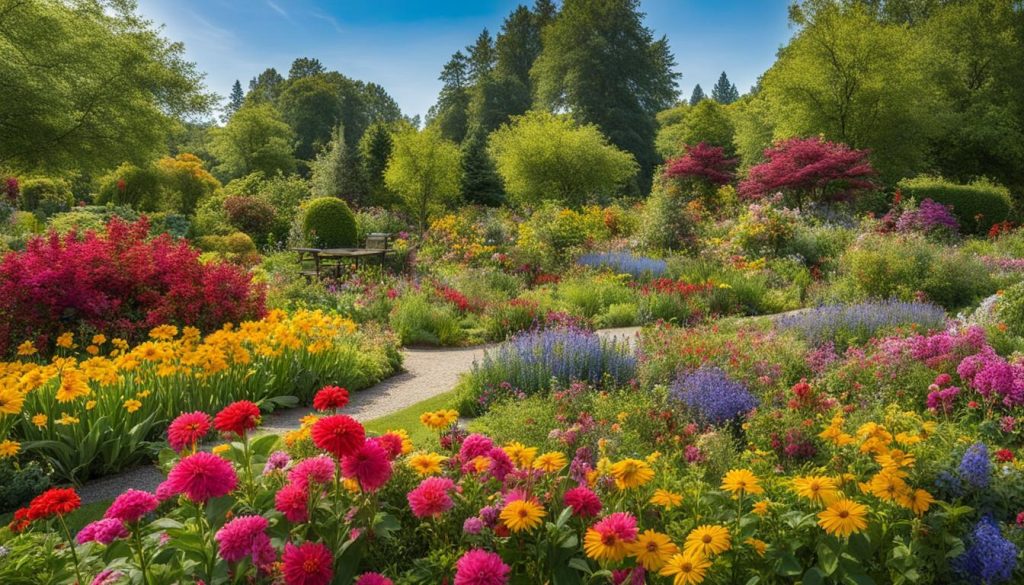
Choosing the Right Flowers for Your Garden
When selecting flowers for your garden, it’s important to choose varieties that are well-suited to the Canadian climate. Native blooms are a great choice as they are adapted to the local environment and require less maintenance than non-native varieties.
One of our favourite native blooms is the wild columbine. This delicate flower features red and yellow bell-shaped blooms and thrives in partial shade. Another great option is the Canada anemone, which showcases beautiful white flowers in late spring and early summer.
If you’re looking for non-native blooms to incorporate into your garden, consider the hardy geranium. This plant is easy to care for and produces stunning pink or blue flowers throughout the summer months. The Black-Eyed Susan is another popular choice, offering bright yellow blooms that attract butterflies and bees.
When selecting flowers for your garden, it’s important to consider their height and growth habits. Mixing taller and shorter flowers can add depth and texture to your flower bed. Be sure to also choose a variety of colours that work well together to create a visually appealing design.
Table: Native vs. Non-Native Blooms
| Native Blooms | Non-Native Blooms |
|---|---|
| Wild Columbine | Hardy Geranium |
| Canada Anemone | Black-Eyed Susan |
| Common Daisy | Hydrangea |
As you can see from the table, both native and non-native blooms offer a wide range of options for your flower landscaping. Consider incorporating a mix of both to create a unique and beautiful garden.
Join us in the next section as we dive deeper into designing your flower beds and creating a stunning landscape.
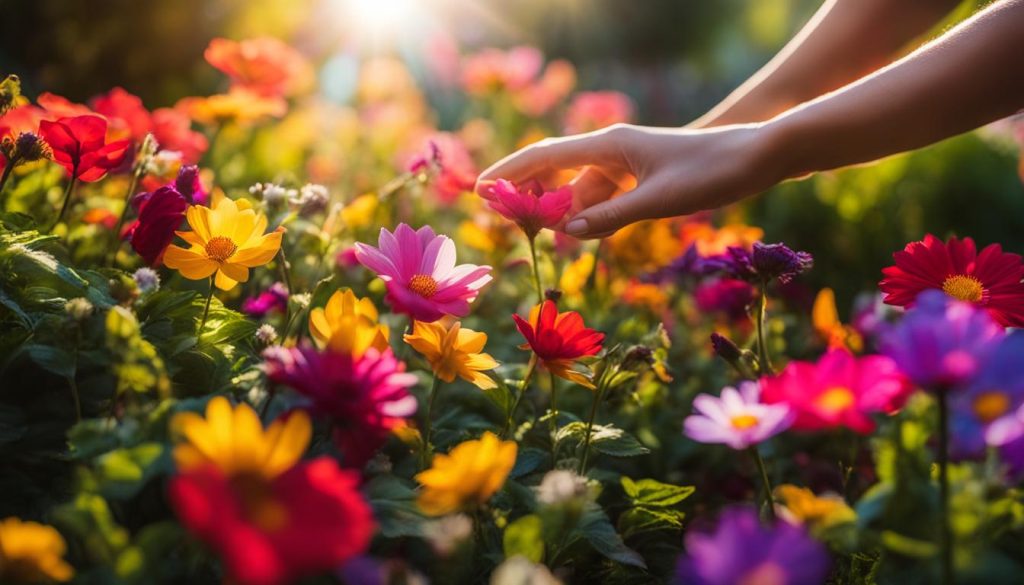
Designing Your Flower Beds
Designing your flower beds is an essential step to create a visually appealing and harmonious landscape. Incorporating different color schemes, height variations, and strategic placement of flowers can transform your garden into a stunning oasis. Here are some tips to help you design your flower beds:
Choose a Color Scheme
When selecting the flowers for your garden, consider choosing a color scheme. This can be monochromatic, analogous, or complementary. A monochromatic color scheme features variations of the same color, while analogous colors are situated next to each other on the color wheel. Complementary colors are situated opposite to each other on the color wheel. To make your flower beds visually appealing, select colors that complement each other or choose a color scheme that matches the style and color of your home.
Tip: Use contrasting colors like purple and yellow or red and green to make your flower beds pop.
Vary Plant Height
One of the most important elements of successful flower bed design is varying the height of plants. Place taller plants towards the back of the bed, and shorter plants towards the front. This will create depth and visual interest in your garden. Consider planting vines or climbing flowers on trellises or arbors to add height and dimension to your landscape.
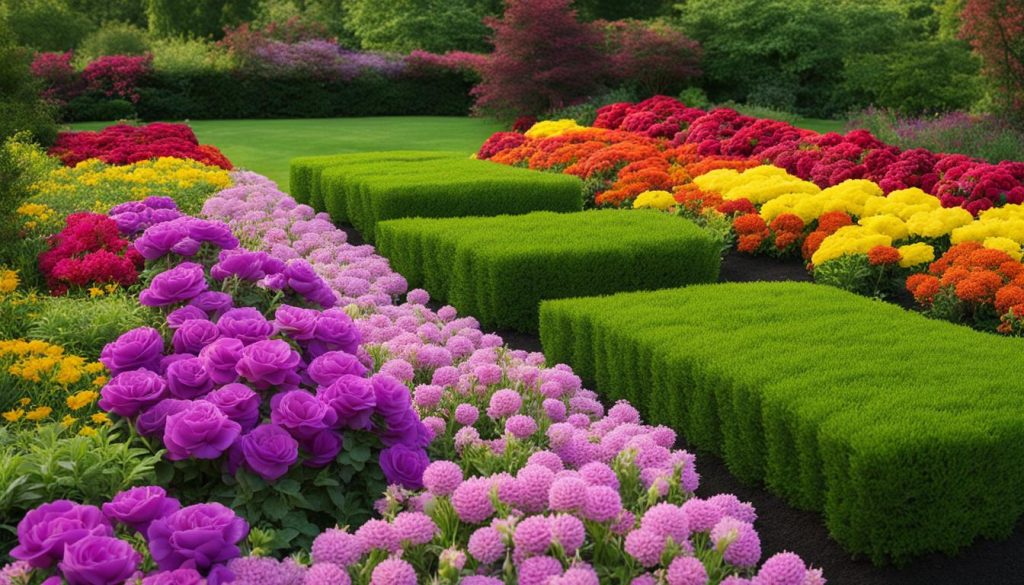
Strategic Placement
Strategic placement of flowers is crucial for a well-designed flower bed. Place larger plants in the center or towards the back of the bed to create a focal point. Use smaller flowers for the edges or borders of the bed. Consider using a mix of annuals and perennials for continuous bloom throughout the growing season.
Create a Theme
Creating a theme for your flower beds can add a cohesive element to your landscape design. Whether it’s a cottage garden, a garden with native plants, or a garden with a specific color scheme, a themed flower bed can create a unique and memorable experience for visitors.
Planting and Maintaining Your Flowers
Proper planting and maintenance are crucial for healthy and vibrant flowers. Follow these steps to ensure your flower landscaping thrives:
Preparing the Soil
Before planting your flowers, it’s important to prepare the soil. Start by clearing the area of any weeds or debris. Then, loosen the soil with a garden fork or tiller to a depth of at least 12 inches. Mix in compost or well-rotted manure to add nutrients and improve drainage.
| Type of Soil | Amount of Compost/Manure to Add |
|---|---|
| Clay Soil | 3-4 inches |
| Sandy Soil | 2-3 inches |
| Silty Soil | 1-2 inches |
Note: If you’re unsure about the type of soil in your garden, consider getting it tested at a local garden center.
Planting Techniques
When planting your flowers, ensure they’re spaced appropriately to allow for proper growth and airflow. Dig a hole that’s slightly wider and deeper than the root ball, and gently remove the plant from its container. Loosen any tangled roots and place the plant in the hole, making sure it’s level with the surrounding soil. Backfill the hole with soil and press down gently to eliminate any air pockets.
Watering and Fertilizing
After planting, water your flowers deeply to help them establish their root systems. Watering frequency will depend on the type of flower and the weather conditions. As a general rule, water when the top inch of soil feels dry to the touch.
Fertilizing is also important for the health of your flowers. Choose a fertilizer that’s appropriate for the type of flower you’re growing, and follow the instructions carefully. Over-fertilizing can burn the roots and damage the plant.
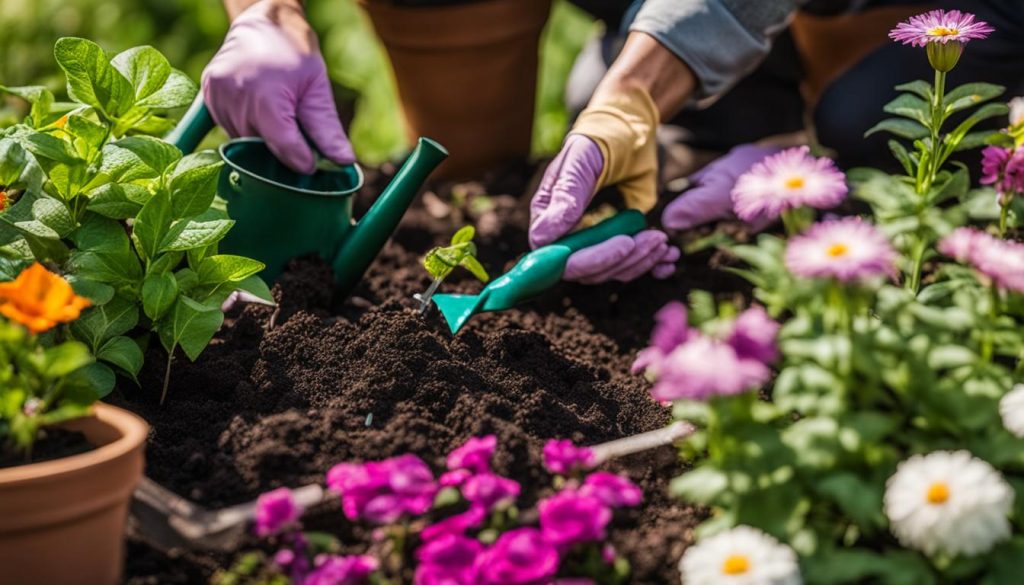
By following these planting and maintenance tips, your flowers will flourish and provide beautiful blooms throughout the seasons.
Creating Flower Landscapes for Different Seasons
One of the best things about flower landscaping is that you can create beautiful displays of blooms year-round. By strategically selecting flowers that thrive in different seasons, you can create a stunning and ever-changing landscape that will impress your visitors and provide enjoyment for you and your family.
Spring Blooms
Spring is the time for new growth and renewal, and your garden can reflect that with an explosion of colorful blooms. Some popular spring flowers for Canadian gardens include:
- Tulips
- Daffodils
- Crocuses
- Hyacinths
- Lilacs
These flowers are ideal for planting in large groups or clusters to create a bold and vibrant display. Their bright colors and charming fragrances make them a favorite among gardeners and wildlife alike.
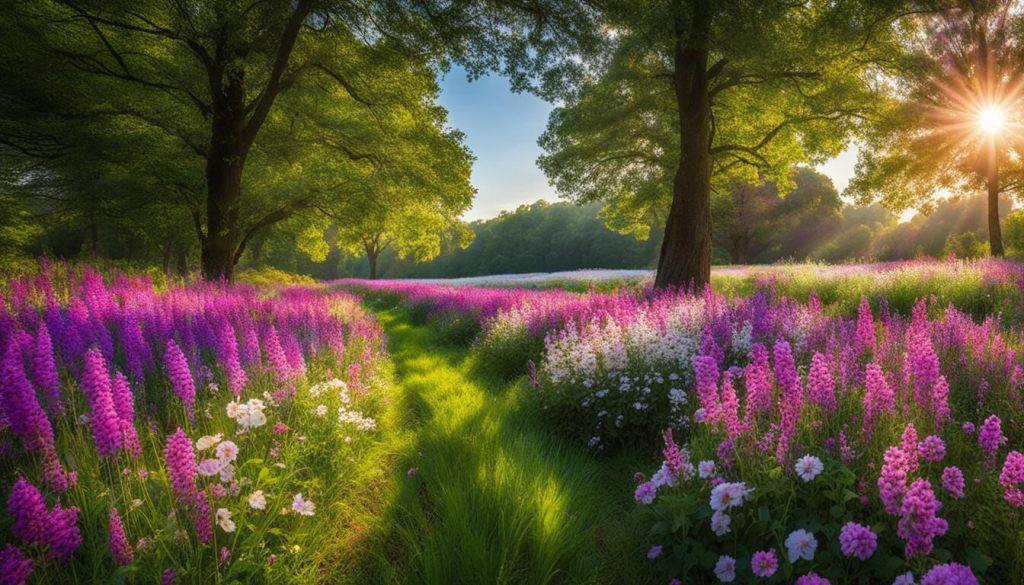
Summer Blooms
Summer is the time for bold and beautiful blooms that can withstand the heat and thrive in the sun. Some popular summer flowers for Canadian gardens include:
- Roses
- Peonies
- Daylilies
- Black-eyed Susans
- Delphiniums
These flowers can be planted in a variety of colors and heights to create a dynamic and eye-catching display. They are also great for attracting pollinators, such as bees and butterflies.
Fall Foliage
As the weather cools down, your garden can still dazzle with stunning fall foliage and blooms. Some popular fall flowers for Canadian gardens include:
- Mums
- Asters
- Goldenrod
- Heleniums
- Sedums
These flowers can add warm and rich colors to your landscape, creating a cozy and inviting atmosphere. They are also great for attracting birds and other wildlife.
Winter Interest
Even in the winter, your garden can still be a breathtaking sight with the right flowers and foliage. Some popular winter flowers for Canadian gardens include:
- Pansies
- Cyclamens
- Snowdrops
- Hellebores
- Winter Jasmine
These flowers can add pops of color and cheer to your winter landscape, while also being hardy enough to withstand the cold temperatures.
With these ideas and inspiration, you can create stunning seasonal flower landscapes that will impress and delight year-round.
Attracting Wildlife to Your Flower Garden
Creating a wildlife-friendly landscape in your flower garden is not only beneficial for the environment but adds an extra touch of beauty to your backyard. By incorporating specific flowers and providing food and water sources, you can attract a variety of pollinators and birds to your garden, creating a harmonious ecosystem.
Choosing Flowers for Pollinators
Bees, butterflies, and hummingbirds are all important pollinators that play a vital role in our ecosystem. Choosing flowers that specifically attract these species will help promote a healthy and diverse garden. Some examples of pollinator-friendly flowers include:
| Flower | Attracts |
|---|---|
| Lavender | Butterflies, Bees, Hummingbirds |
| Sunflowers | Butterflies, Bees, Hummingbirds |
| Coneflowers | Butterflies, Bees, Hummingbirds |
| Zinnias | Butterflies, Bees, Hummingbirds |
When selecting flowers for pollinators, consider planting a variety of colors and shapes to attract different species. Remember to plant flowers in clusters to make it easier for pollinators to locate them.
Creating Bird Habitats
Birds are not only pleasant to watch fluttering around your garden but also play an important role in controlling pests and promoting seed dispersal. Providing birds with habitat, food, and water will encourage them to make your garden their home. Consider the following tips:
- Plant berry bushes or fruit trees to provide a food source for birds.
- Install a birdhouse or bird bath to create a safe habitat for birds to nest and drink water.
- Leave leaf litter or brush piles to provide shelter for birds.
Creating a Wildlife-Friendly Landscape
Incorporating these elements in your garden will attract various pollinators and birds, creating a biodiverse and beautiful ecosystem in your backyard. With the proper planning and maintenance, you can create a wildlife-friendly landscape that both you and the environment will appreciate.
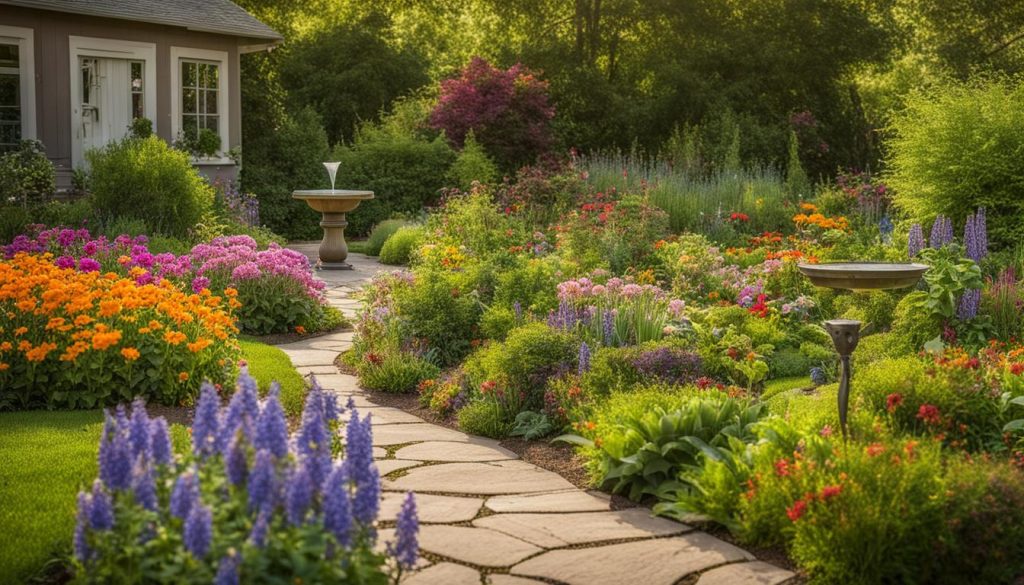
The Final Touches: Accessories and Accents
Adding garden accessories and accents to your flower landscape can take your outdoor space to the next level. Not only do they enhance the overall beauty of your garden, but they also provide functional benefits.
Functional Garden Accessories
Garden accessories such as bird feeders and baths can attract wildlife, including birds, to your garden. This not only adds to the natural beauty of your space but also helps to pollinate your flowers naturally. Adding seating areas such as benches or chairs can also provide a comfortable space for you to enjoy your garden and entertain guests.
Decorative Elements
Decorative elements such as garden sculptures, wind chimes, and garden stakes can be used to add a personal touch to your flower landscape. These decorative elements can be strategically placed throughout your garden and can complement the colors and shapes of your flowers, making your garden more cohesive and visually appealing.
Flower Garden Accents
Flower garden accents such as planters, trellises, and garden edging can also add a unique touch to your flower landscape. Planters can be used to display flowers in different locations throughout your garden. Trellises can be used to support climbing flowers such as clematis or sweet peas. Garden edging can be used to create defined borders between different areas of your garden, adding structure to your landscape.
By incorporating garden accessories, decorative elements, and flower garden accents into your landscape design, you can create a truly stunning and functional outdoor space that you can enjoy year-round.
If you have any questions, contact us! Our team is always happy to help.
FAQ
What are the benefits of flower landscaping?
Flower landscaping not only adds beauty to your garden but also enhances curb appeal, attracts beneficial insects, and improves air quality.
How do I choose the right flowers for my garden?
When selecting flowers, it’s important to consider the Canadian climate and choose native varieties that are well-adapted to the local environment.
How can I design visually appealing flower beds?
To create eye-catching flower beds, consider using various color schemes, height variations, and strategic placement of different blooms.
What do I need to know about planting and maintaining flowers?
Proper planting techniques, soil preparation, watering schedules, and fertilizing practices are essential for the health and longevity of your flowers.
Can I create flower landscapes for different seasons?
Absolutely! You can enjoy flower landscaping year-round by incorporating seasonal blooms that showcase the beauty of each season, including spring blossoms, summer blooms, fall foliage, and even winter interest.
How can I attract wildlife to my flower garden?
By including specific flowers, providing food and water sources, and creating habitats, you can attract and support various species of wildlife, including pollinators and birds.
What are some ideas for adding accessories and accents to my flower garden?
You can enhance the overall beauty and functionality of your outdoor space by incorporating garden accessories such as sculptures, bird feeders, and seating areas.

